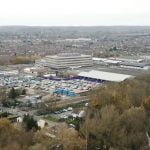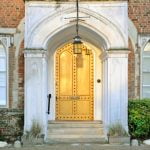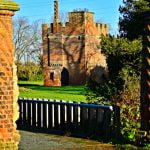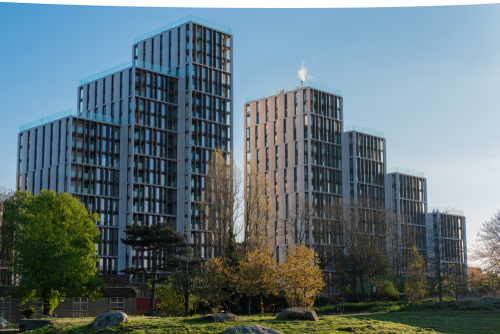
The London Borough of Harrow is situated in the north-west of the Greater London Area. It borders four other London boroughs; Barnet to the east, Brent to the south-east, Ealing to the south and Hillingdon to the west, as well as the Hertfordshire districts of Three Rivers and Hertsmere to the north. In 1965, under the London Government Act, the municipality of Harrow was abolished and renamed the London Borough of Harrow. Simultaneously, the administrative jurisdiction of the new borough transferred from Middlesex to the Greater London Council. With a population of well over 200,000, Harrow was the only district under the 1963 Act to have its boundaries unchanged to form a new single authority. The area of the borough covers 50 sq. km and at the time of the 2011 UK Census had a population of 239,056.
A Very Brief History
The story of the Borough of Harrow starts back in the early Middle Ages. With its natural defensive advantage, being some 70m above the surrounding plain, Harrow-on-the-Hill was probably home to the earliest settlers in the area. It was also the probable location of an Anglo-Saxon religious shrine, as ‘Harrow’ is derived from the Anglo-Saxon for ‘heathen shrine’.
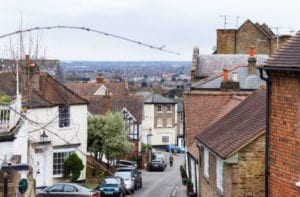
Typical street scene of today’s Harrow-on-the-Hill
The late Middle Ages saw some of the borough’s most notable landmarks being build such as Headstone Manor in 1310. In 1336, King Edward III granted a charter for Pinner Fair, an event which continues to this day. The borough experienced widespread rioting in 1381 when Wat Tyler led the Peasants’ Revolt against the crown. It was England’s first popular uprising, which had initially come about due to the imposition of a harsh poll tax. The rebellion was quickly crushed by the young King Richard II forces, and Wat Tyler died at the hands of the Lord Mayor of London. However, the event proved a catalyst for change, as it eventually brought about the end of serfdom and forced labour.
In 1642, at the outbreak of the English Civil War, the borough’s famous hill was more than likely became the site of a military base for parliamentarian forces. Harrow, was also linked to arguably Britain’s most famous parliamentarian, Oliver Cromwell, through local landowner Sir Gerard Gilbert, who was a close ally of the revolutionary.
In the 18th and 19th centuries, saw a number of notable characters being born or living in the borough. The widowed Queen Adelaide, consort of William IV, moved to Bentley Prior during the mid-19th-century in the last few years of her life. Perhaps one of the UK’s best-known poets, Lord Byron, went to school in Harrow for 4 years at the turn of the 19th century. Dubbed the world’s greatest miser, and undoubtedly the inspiration for Dickens’s Scrooge, Daniel Dancer (1716 – 1794) was born and lived his entire life in Pinner. The world’s first celebrity chef and well-known philanthropist, Mary Isabella Beeton, better known as Mrs Beeton, also lived in Pinner during the mid 19th century.
As the 1800s came to a close and the 1900s began, the winds of industrialisation began to spread across the nation, and across Harrow also. This initially gave rise to a macabre lineage of being the first to see transportation accidents – first with the death of Thomas Port by rail (immortalised by a headstone at St. Mary’s), and then with the first-ever fatal car accident at Grove Hill. However, in time, this industrialisation eventually saw the likes of Whitefriars Glassworks and Kodak come to Harrow – until recently providing jobs for the local population, and all the while contributing to the transformation of the world.
The development of the railway network, which came to Harrow-on-the-Hill in 1837 strengthened the borough’s connection to central London. This resulted in the rapid urbanisation of the borough, new-found local wealth and the construction of some its finest buildings which mostly still stand today. Harrow, as with suburbia elsewhere, became an ideal location for workers needing quick access to the city centre but who chose to live outside its chaos. Almost 200 years later, this still remains true as a facet of the borough.
WWI
The First World War saw the emergence of a local hero in Willaim Leefe Robinson, a pilot who happened to be living in Harrow when he shot down one of the first German airships to terrorise London. He was the first person to be awarded the VC for action in the UK. Later in the war, he was shot down, wounded and captured by the Germans in France in April 1917. He spent the rest of the war in a German prisoner of war camp but made several attempts to escape. In December 1918, he was repatriated back to London but unfortunately died of the Spanish Flu less than a month later.
In 1934, Harrow Urban District was formed as part of Middlesex, resulting from a merger of Harrow-on-the-Hill Urban District, Hendon Rural District and Wealdstone Urban District
During WW2, the RAF’s Fighter Command set up at the Borough’s Bentley Priory, an action that would help to dictate the course of the war. Similarly, Grim’s Dyke, which was once the home of dramatist W.S. Gilbert, was used for secret military work during World War II. Although many of the details are still classified, it’s believed the manor house was a base from which captured German machinery and aircraft parts were examined. It is thought the secret work carried out at Grim’s Dyke was so important to the war effort, both Winston Churchill and General Eisenhower paid visits to the house.
In 1954, Harrow urban district gained the status of a municipal borough, with the urban district council becoming Harrow Borough Council. In 1965 the Municipal Borough was abolished and its former area transferred to Greater London to form the London Borough of Harrow. Uniquely, it was the only London borough that retained unchanged boundaries from a former single district authority.
Famous people From Harrow
Famous people who were born, have lived or who are living in the London Borough of Harrow, include:
- Patrick Moore, world-renowned astronomer, born in Pinner (1923 – 2012)
- Lord Byron, world-renowned poet, was educated at Harrow School 1801–1805
- W. S. Gilbert, of Gilbert and Sullivan fame, lived and died at Grim’s Dyke in Harrow Weald (1836 – 1911)
- Sir Elton John, contempary singer and musician, brought up in Pinner Hill Road
- Roger Moore, actor, famous for his role as James Bond, lived in Stanmore (1927 – 2017)
- Vivienne Westwood, Dame Vivienne Westwood, fashion designer moved to Harrow aged 17
- Mrs Beeton, first celebrity cook, philanthropist, lived on Uxbridge Road, Hatch End (1836 – 1865)
- Heath Robinson, cartoonist and social commentator, lived in Pinner (1872 – 1944)
- Winston Churchill, British Prime Minister, attended Harrow School 1888 – 1892
- Sir Oswald Mosley, infamous local MP in the 1920s, became the leader of British Union of Fascists in 1930s
- Jawaharlal Nehru, first Prime Minister of India, educated at Harrow School 1905 – 1907
Did you know?
- Roger Banister, the first person ever to run a mile in under 4 minutes, was born in Harrow in 1929
- In 1955, Winston Churchill, who attended Harrow School, was the first person ever to receive the freedom of the Borough
- Anthony Trollope, renowned novelist, educated at Harrow School; is credited with the creation of the UK’s iconic red postal box
- The prestigious Harrow School was originally established for the poor boys of the Borough – pupils were only to speak Latin or Greek!
- The modern game of squash was developed from a game called ‘rackets’ at Harrow School in the early 19th century
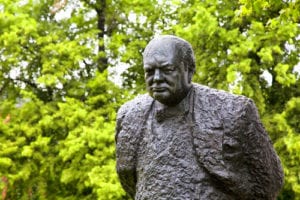
Winston Churchill was Harrow’s first freeman of the Borough
Getting Around In Harrow
In general, it’s often cheaper and more convenient to get around London by public transport rather than by car, due to road charges and difficulties in parking.
Road
The principal roads running through the borough include the A404, A408, A409 and the A4140. There are numerous bus services which run throughout the borough operated by Transport for London.
Train
The Borough is served by the London Overground, the Underground (Tube) and the national rail network.
Underground (Tube) stations
- Canons Park
- Harrow & Wealdstone
- Harrow-on-the-Hill
- North Harrow
- Pinner
- Rayners Lane
- South Harrow
- Stanmore
- Sudbury Hill
- West Harrow
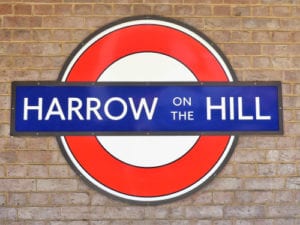
Harrow is served by the Underground’s Metropolitan Line
National Railway Stations
- Harrow & Wealdstone station
- Harrow-on-the-Hill station
- Hatch End railway station
- Headstone Lane railway station
- Sudbury Hill Harrow railway station
London Overground
- Harrow & Wealdstone
- Headstone Lane
- Hatch End
Things to see and do!
Parks and open spaces
- Aldenham Country Park – Vast wood & parkland with a large lake, rare breeds farm and activities
- Bentley Priory – 66-hectare of open space and local nature reserve
- Canons Park: 18-hectare of 18th-century parkland
- Harrow Weald Common – 32-hectare of park and woodland
- Headstone Manor Recreation Park – 23 hectare of parkland
- Pinner Park Farm – 93 hectare of a conservation area
- Stanmore Common – 49-hectare public park, local nature reserve and conservation area
- Stanmore Country Park – 31-hectare local nature reserve and conservation area
Tourist attractions
- Bentley Priory – Collection of RAF memorabilia set in a historic home/former military HQ
- Heath Robinson Museum – Showcases the work of the renowned artist, humourist and social commentator, William Heath Robinson
- Headstone Manor and Museum – 14th-century manor and history museum
- ISKCON Bhaktivedanta Manor – Hare Krishna centre in mock-Tudor house
- St Lawrence Church – Grade I listed building in parish of Little Stanmore
Where to stay?
There is a limited choice of budget accommodation in or around to the Borough of Harrow. However, there’s plenty of very reasonably priced B & B/Guesthouse/Travel Lodge style accommodation on offer. If you’re looking for a bit more luxury then there’s also plenty 3 and 4 hotel-style accommodation. There is also plenty of available apartments, which tend to cater for between 2 and 6 people. They can often work out cheaper than hotels for larger parties but there is also a big difference in standards across the range. Indicative prices for the most readily available types of accommodation/per night, based on 2 adults sharing, unless otherwise indicated, are as follows:
Budget: £35 – £45 (1 or 2 people sharing)
B & B/Guesthouse/Travel Lodge: £50 – £150
3/4 Star Hotel: £150 – £250
Apartments vary greatly based on no. of available berths, location and standard
If you enjoyed this London guide, check out some of our other London guides by clicking the link below.

